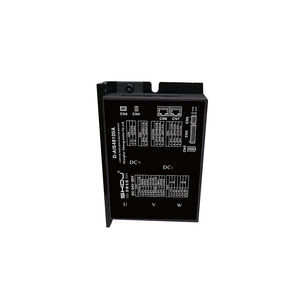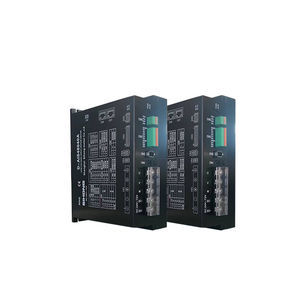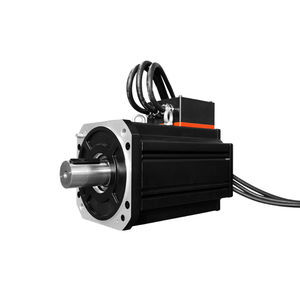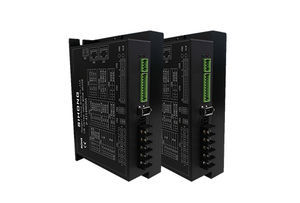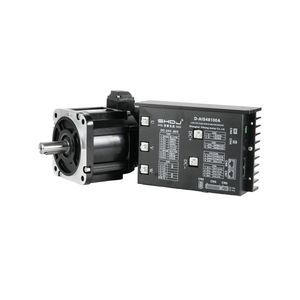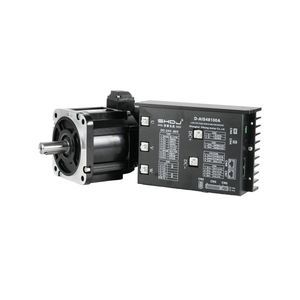
- Механика-Силовая передача
- Двигатель и Управление двигателем
- Сервовариатор DC
- Shanghai Siheng Motor Co., Ltd
- Продукция
- Каталоги
Сервовариатор DC D – AIS72200AModbusRS-485для управления
Добавить в папку «Избранное»
Добавить к сравнению
Характеристики
- AC/DC
- DC
- Выходной сигнал
- RS-485, Modbus
- Применение изделия
- для управления, для позиционирования
- Другие характеристики
- компактный, высокоэффективный, с контролем крутящего момента, умный, низкого напряжения, умный, многофункциональный
- Интенсивность
МАКС.: 300 A
МИН.: 8 A
Описание
Product Details D – AIS72200A Low Voltage Intelligent Servo Motor Driver Product Information This product features strong stability, high-precision positioning, high motor response, low noise, low heat generation, excellent structural design, strong overload capacity, practical and rich functions, and simple and convenient application. It has protection against over-voltage, under-voltage, overspeed, overcurrent, overload, encoder faults, position deviation, stall, parameter deviation, etc. Technical Specifications Drive ModelVoltage Range (V)Rated Current (A)D – AIS24008A24 – 368D – AIS48015A24 – 4815D – AIS48025A24 – 6025D – AIS48050A24 – 7250D – AIS48100A36 – 72100D – AIS72200A48 – 96200D – AIS72300A48 – 96300 Control Method① Position control ② Speed control ③ Torque control ④ Communication controlControl FeaturesSpeed frequency response: ≥200 Hz, Pulse input frequency ≤200 kHz, Speed variation: < ±0.03 (Load 0 – 100%): < ±0.02×(0.9 – 1.1) Power supply voltageMonitoring FunctionCurrent speed, DI input, DO output, Current position, Command pulse accumulation, Average load speed, Position deviation counter, Motor phase current, Bus voltage value, Module temperature, Alarm record, Command pulse frequency corresponding to speed, Operating status, etc.Home Return Function13 types of autonomous (search) home return modes, and home offset functionRS485 FunctionComplies with Modbus-RTU protocol, one-to-two communication interface for easy networking and parallel connection Driver Installation Dimensions Product Model: D – AIS72200A Rated Voltage: 48 – 96V Rated Current: 200A Split-type Driver Hardware Interface Applicable drive models: D – AISXX005A / D – AISXX0015A / D – AISXX0025A / D – AISXX0040A / D – AISXX00100A / D – AISXX00200A Split-type AI MOTOR Driver Interface Diagram Serial No.SymbolFunctionNotesCn11UMotor U-phaseJVW-interface power cable for motor adaptation2VMotor V-phase3WMotor W-phase4DC–Negative pole of input power supplyExternal DC input must distinguish positive and negative poles; voltage range: 48V DC5DC+Positive pole of input power supplyCn215V+Encoder power interfacePower interface for encoder adaptation2GNDPower interface3NCEmpty terminalNo function4NCEmpty terminalNo function5SD+Encoder communication interfaceCommunication interface for sensor adaptation6SD–Cn31DI–COMCommon input signal terminalCommon terminal for all DI signals. When DI–COM is connected to positive, negative DI control is effective; when connected to negative, positive DI control is effective.2DI1Input signal 1Default: Servo enable3DI2Input signal 2Default: Alarm reset4DI3Input signal 3Default: Emergency stop5DI4Input signal 4Default: JOG positive run6DI5Input signal 5Default: JOG negative run7DO–COMCommon output signal terminalCommon terminal for all DO signals. When DO–COM is connected to positive, positive DO output is effective; when connected to negative, negative DO output is effective.8DO1Output signal 1Default: Servo ready9DO2Output signal 2Default: Fault alarm output10DO3Output signal 3Default: Positioning completion outputCn41BRK+Brake output positiveInterface for mechanical brake adaptation2BRK–Brake output negative Reference Table for Selecting Discharge Brake Resistor for Split-type Driver Interface Cn9 Split-type Drive ModelRated Output CurrentExternal Brake Resistor Resistance RequirementExternal Brake Resistor Power RequirementD – AISXX008A8A10 – 30 Ω rangeOver 100WD – AISXX0015A15A10 – 30 Ω rangeOver 100WD – AISXX0025A25A10 – 30 Ω rangeOver 100WD – AISXX0050A50A5 – 15 Ω rangeOver 200WD – AISXX00100A100A5 – 15 Ω rangeOver 200WD – AISXX00200A200A5 – 15 Ω rangeOver 200W Standard Wiring Diagram Power Input Wiring Note 1: Power input terminals must strictly distinguish positive and negative poles. The input voltage range may differ for different models. Refer to the hardware interface wiring diagram for the corresponding model above. Note 2: This product has a certain overload capacity. When selecting an external pulse power supply, the output power should be 1.5 times the rated current of this product. The rated current is indicated on the nameplate. High-speed Pulse Signal Wiring Collector-open Wiring Differential Signal Wiring Note 1: For different motors, the terminal positions of the pulse input interface may differ. Please refer to the hardware interface description for the corresponding model above. Note 2: This product supports wide voltage range pulse input, 5 – 24V, and the maximum pulse input frequency is 200 kHz. The upper-level pulse device should limit the frequency within 200K to prevent the driver from losing pulses and causing positioning errors. Note 3: It is recommended to use double-shielded wires for pulse control lines and avoid routing them in the same circuit as strong current interference sources, which can effectively shield external strong magnetic interference. Note 4: The above pulse connection methods should comply with H05-15 parameters. The factory default for H05-15 is pulse + direction command mode. DI and DO Terminal Wiring DI Terminal Input Wiring Note 1: The control voltage of the input terminals is valid at DC12 – 24V. Note 2: Each digital input can be freely assigned different functions (see section 4.2 DIDO parameter section), but the same function cannot be assigned to multiple DIs. Note 3: For external DC switch signal control input, select NPN connection (low level effective); for external DC+ switch signal input, select PNP connection (high level effective). DO Terminal Output Wiring Note 1: The maximum output current of the output terminals is <300mA. If a large load is required, use a relay for conversion. Note 2: Each DO can be freely assigned different functions (see section 4.2 DIDO parameter section). Note 3: For DO port action control, if DC– is output, select NPN connection (low output level effective); if DC+ is output, select PNP connection (high output level effective). RS485 Communication Wiring Multi-slave Connection Note 1: For multi-slave connection, if the communication signal noise is high, it is recommended to add a 120Ω terminal resistor to the last slave device to ensure communication quality. Note 2: For communication-related content, refer to (section 4.5 RS485-related parameters). Debugging Connection with Host Computer Note 1: Normally, computers do not have a direct 485 interface, and a USB-to-485 converter is required to connect to the slave drive. Note 2: The host computer debugging software for PC can be downloaded from the official website for convenient debugging. Key Features / Technical Specifications: Model: D – AIS72200A Voltage Range: 48 – 96V Rated Current: 200A Control Modes: Position, Speed, Torque, Communication Speed Frequency Response: ≥200 Hz Pulse Input Frequency: ≤200 kHz RS485 Communication: Modbus-RTU protocol Multiple protection features: over-voltage, under-voltage, overcurrent, overload, encoder fault, etc. Rich monitoring and diagnostic functions Comprehensive wiring and interface options
Другие изделия Shanghai Siheng Motor Co., Ltd
Split DC servo motor and driver
Расширенный поиск
- Двигатель для транспортного средства
- Двигатель с постоянным током
- Двигатель AC
- Синхронный двигатель
- Мотор-редуктор
- Промышленный двигатель
- Мотор-редуктор Постоянный ток
- Двигатель BLDC
- Двигатель 24 В
- Промышленный мотор-редуктор
- Концентричный мотор-редуктор
- Эпициклоидальный мотор-редуктор
- Сервовариатор
- Электрический серводвигатель
- Ортогональный мотор-редуктор
- Мотор-редуктор CA
- Шаговый двигатель
- Двигатель 220 В
- Серводвигатель AC
- Сервовариатор с постоянным током
* Цены указаны без учета налогов, без стоимости доставки, без учета таможенных пошлин и не включают в себя дополнительные расходы, связанные с установкой или вводом в эксплуатацию. Цены являются ориентировочными и могут меняться в зависимости от страны, цен на сырьевые товары и валютных курсов.


